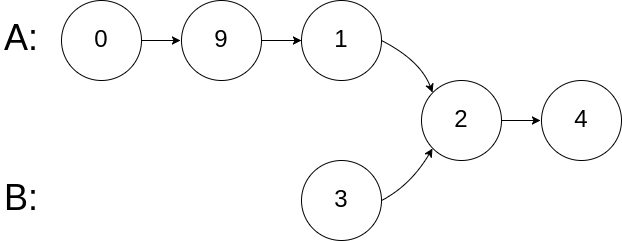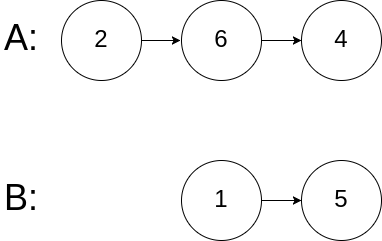160. 相交链表
2019-11-09 16:01:15来源:博客园 阅读 ()

160. 相交链表
编写一个程序,找到两个单链表相交的起始节点。 如下面的两个链表:




1 class Solution { 2 public: 3 ListNode *getIntersectionNode(ListNode *headA, ListNode *headB) { 4 set<ListNode*> node_set; 5 while (headA) { 6 node_set.insert(headA); 7 headA = headA->next; 8 } 9 while (headB) { 10 if (node_set.find(headB) != node_set.end()) { //find()没找到,返回 end() 11 return headB; 12 } 13 headB = headB->next; 14 } 15 return NULL; 16 } 17 };
思路 2 计算链表长度和长度之差
 将长链表指针移动到和短链表对齐
将长链表指针移动到和短链表对齐
 headA 和 headB 同时移动,直到两指针指向同一节点
headA 和 headB 同时移动,直到两指针指向同一节点

1 class Solution { 2 public: 3 ListNode *getIntersectionNode(ListNode *headA, ListNode *headB) { 4 int list_A_len = getListLength(headA); 5 int list_B_len = getListLength(headB); 6 if (list_A_len > list_B_len) { 7 headA = forwardLongList(headA, list_A_len, list_B_len); 8 } else { 9 headB = forwardLongList(headB, list_B_len, list_A_len); 10 } 11 while (headA && headB) { 12 if (headA == headB) { 13 return headA; 14 } 15 headA = headA->next; 16 headB = headB->next; 17 } 18 return NULL; 19 } 20 private: 21 //计算链表长度 22 int getListLength(ListNode* head) { 23 int len = 0; 24 while (head) { 25 ++len; 26 head = head->next; 27 } 28 return len; 29 } 30 31 //将长链表指针向后移动,返回对齐后的位置 32 ListNode* forwardLongList(ListNode* long_head, int long_len, int short_len) { 33 int delta = long_len - short_len; 34 while (long_head && delta) { 35 long_head = long_head->next; 36 --delta; 37 } 38 return long_head; 39 } 40 };
测试

1 int main(int argc, const char * argv[]) { 2 ListNode a1(1); 3 ListNode a2(2); 4 ListNode b1(3); 5 ListNode b2(4); 6 ListNode b3(5); 7 ListNode c1(6); 8 ListNode c2(7); 9 ListNode c3(8); 10 a1.next = &a2; 11 a2.next = &c1; 12 c1.next = &c2; 13 c2.next = &c3; 14 b1.next = &b2; 15 b2.next = &b3; 16 b3.next = &c1; 17 18 Solution solve; 19 ListNode *result = solve.getIntersectionNode(&a1, &b1); 20 cout <<result->val; 21 22 return 0; 23 }View Code
原文链接:https://www.cnblogs.com/i-8023-/p/11825774.html
如有疑问请与原作者联系
标签:
版权申明:本站文章部分自网络,如有侵权,请联系:west999com@outlook.com
特别注意:本站所有转载文章言论不代表本站观点,本站所提供的摄影照片,插画,设计作品,如需使用,请与原作者联系,版权归原作者所有
下一篇:POJ1852
- leetcode 反转链表 2020-06-06
- 数据结构—链表 2020-05-29
- STL之list 2020-04-30
- 单链表 2020-03-31
- DSA_04:链表 2020-03-28
IDC资讯: 主机资讯 注册资讯 托管资讯 vps资讯 网站建设
网站运营: 建站经验 策划盈利 搜索优化 网站推广 免费资源
网络编程: Asp.Net编程 Asp编程 Php编程 Xml编程 Access Mssql Mysql 其它
服务器技术: Web服务器 Ftp服务器 Mail服务器 Dns服务器 安全防护
软件技巧: 其它软件 Word Excel Powerpoint Ghost Vista QQ空间 QQ FlashGet 迅雷
网页制作: FrontPages Dreamweaver Javascript css photoshop fireworks Flash

